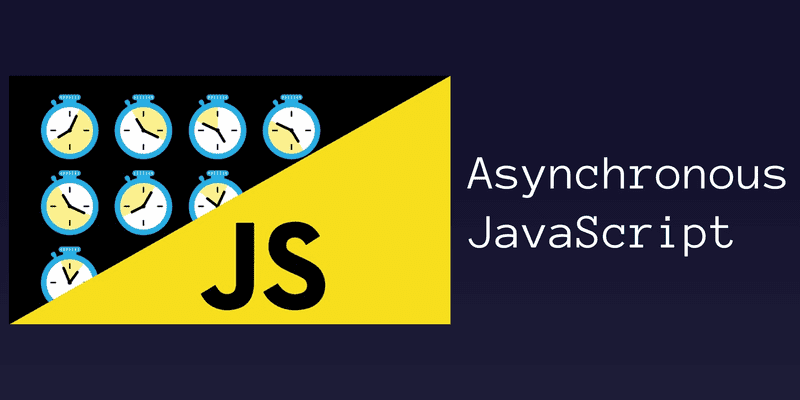Asynchronous JavaScript
 Abhijeet Karmakar
Abhijeet Karmakar
Asynchronous JavaScript
JavaScript Code Execution
JavaScript engines consist of two main components: the heap and the function call stack. Additionally, there is a callback queue, a microtask queue, web APIs/Node APIs, and the event loop.
When JavaScript code executes, a global execution context is created in the call stack, and all synchronous code is directly placed in the call stack. When an asynchronous task is encountered, its callback is placed in the callback queue. Promises have their special queue, known as the microtask or priority queue, which is executed before the callback queue.
The event loop is responsible for transferring functions from the callback or microtask queue to the call stack whenever the call stack is empty. This mechanism allows JavaScript to handle asynchronous tasks efficiently, giving the appearance of a multi-threaded language, despite being single-threaded.
Synchronus And Asynchronous Code
- Synchronous (Sync): Code is executed line by line. Each operation waits for the previous one to complete before executing.
- Asynchronous (Async): Code does not wait for an operation to complete and can move on to execute other operations. This allows for non-blocking behavior.
Ways to Make the Code Asynchronous
We can use the following methods:
- Callbacks: Passing a function to be executed after another function completes.
- Promises: An object representing the eventual completion or failure of an asynchronous operation.
- Async/Await: Syntactic sugar built on top of promises, making asynchronous code look synchronous.
Web Browser APIs
- Web Browser APIs are interfaces provided by the browser to interact with different aspects of the web environment, such as:
- DOM API: Manipulate HTML and CSS
const one = document.getElementById("one"); - Fetch API: Perform network requests. ()
fetch("https://example.com") .then((data) => console.log(data)) .catch((error) => console.log(error)); - Web Storage API: Store data locally.
localStorage.set("key", 1); - Geolocation API: Get geographical position of the device.
- DOM API: Manipulate HTML and CSS
Event Loop?
- The event loop is a mechanism that allows JavaScript to perform non-blocking operations, despite being single-threaded.
- It continuously checks the call stack and the callback queue(or task queue), putting the callback functions from the callback queue to the call stack if the stack is empty.
Promises in JavaScript
Disadvantages of using callback in asynchronous operations
Callback Hell: It refers to the situation where callbacks are nested within other callbacks, leading to code that is hard to read and maintain.
Inversion of Control: When a callback function is passed to another function, control over the execution of the callback is inverted, meaning the function receiving the callback decides when and how to execute it.
Promise
- A promise is an object representing the eventual completion or failure of an asynchronous operation. It provides a cleaner, more manageable way to handle async operations.
How to Create a New Promise?
const promise = new Promise((resolve, reject) => {
// async operation
if (success) {
resolve("Promised Resolved!");
} else {
reject("Error!");
}
});
States of Promise
Promises has three states:
Pending: By default, a promise has a pending state. It means the promise is neither resolved nor rejected yet.
Resolved: It means the operation is successfully completed and the promise has been fulfilled or resolved.
Rejected: It means the operation has failed and the promise is rejected.
Ways to consume a promise
- Using
.then()and.catch(): Here .then() handles the fulfillment of the promise and .catch() handles the rejection of the promise.
const promise = new Promise((resolve, reject) => {
// async operation
if (success) {
resolve("Promised Resolved!");
} else {
reject("Error!");
}
});
promise
.then((data) =>
// code to handle the fulfillment
)
.catch((error) =>
// code to handle the rejection
)
- Using Async-Await: Here await keyword makes the code look synchronous and waits for the promise to get either resolved or rejected then executes the code further.
const promise = new Promise((resolve, reject) => {
// async operation
if (success) {
resolve("Promised Resolved!");
} else {
reject("Error!");
}
});
async function getData() {
try {
const data = await promise;
console.log(data);
} catch (err) {
console.log(err);
}
}
getData();
Note: Async-Await does not implicitly handle errors while consuming the promise. Therefore it needs to be wrapped in a try-catch block to prevent unhandled promise rejection error.
Chain promises using .then
Promise chaining is used when you are performing a series of asynchronous tasks where each subsequent task is dependent on the previous task.\ In this scenario, we can chain the promises using .then where each .then returns a value to the next .then avoids callback hell and better code readability.
promise
.then((value) => {
// first handler
return newValue;
})
.then((newValue) => {
// second handler
return anotherNewValue;
})
.then((anotherNewValue) => {
// third handler
})
.catch((error) => console.log(error));
Handle errors in promises
In promises, a catch block is used to handle the error that might have occurred during the asynchronous operation.\ If using .then then .catch can be directly chained with the .then block and if using async-await then .catch needs to be used as a try-catch block.
promise
.then((data) =>
// code to handle the fulfillment
)
.catch((error) =>
// code to handle the rejection
)
OR
try {
// code to handle the fulfillment
} catch (error) {
// code to handle the rejection
}
.finally() block in a promise chain
A .finally block will always execute regardless of the promise getting resolved or rejected.
promise
.then((value) => {
// first handler
return newValue;
})
.then((newValue) => {
// second handler
return anotherNewValue;
})
.then((anotherNewValue) => {
// third handler
})
.catch((error) => {
// error handler
})
.finally(() => {
// final actions
});
Behaviour of Error inside a .then()
- When there is a .catch: The error is caught and handled by the .catch block.
- When there is no .catch: The error propagates and may cause unhandled promise rejection.
.catch() at the end
The .catch() block must be placed at the end to ensure we catch any error that might have occurred in any of the preceding .then() block.
Promisify an asynchronous callbacks based function
Promifying a synchronous callback-based function is done by returning a promise from the function accepting another function as a callback.\ The returned promise can consumed with JavaScript's modern way of handling asynchronous operations with promises or async-await.
function promisifiedSetTimeout(delay) {
return new Promise((resolve) => {
setTimeout(resolve, delay);
});
}
// Usage with promises
promisifiedSetTimeout(1000).then(() => {
console.log("1 second has passed");
});
// Usage with async/await
async function usingAwait() {
await promisifiedSetTimeout(1000);
console.log("1 second has passed");
}
usingAwait();
Promise based functions
Promise.resolve
Promise.resolveis used to return a promise that is already resolved with a given value.
const resolvedPromise = Promise.resolve("Resolved value");
resolvedPromise.then((value) => {
console.log(value); // Output: Resolved value
});
Promise.reject
Promise.rejectis used to return a promise that is already rejected with a given reason.
const rejectedPromise = Promise.reject("Rejected reason");
rejectedPromise.catch((reason) => {
console.log(reason); // Output: Rejected reason
});
Promise.all
Promise.allis used to wait for all promises to be resolved or for any to be rejected. It takes an array of promises and returns a single promise that resolves when all of the promises in the array have resolved, or rejects with the reason of the first promise that rejects.
const promise1 = Promise.resolve(3);
const promise2 = 42;
const promise3 = new Promise((resolve, reject) => {
setTimeout(resolve, 100, "foo");
});
Promise.all([promise1, promise2, promise3])
.then((values) => {
console.log(values); // Output: [3, 42, 'foo']
})
.catch((error) => {
console.error(error);
});
Promise.allSettled
Promise.allSettledwaits for all promises to settle (each may be resolved or rejected). It returns a promise that resolves after all of the given promises have either been resolved or rejected, with an array of objects with each object containing status and value (if resolved) or reason (if rejected).
const promise1 = Promise.resolve("resolved");
const promise2 = Promise.reject("rejected");
Promise.allSettled([promise1, promise2]).then((results) => {
results.forEach((result) => console.log(result));
// Output:
// { status: 'fulfilled', value: 'resolved' }
// { status: 'rejected', reason: 'rejected' }
});
Promise.any
Promise.anytakes an array of promises and returns a single promise that resolves with the first promise that fulfills. If none of the promises fulfill (if all of the given promises are rejected), it returns a promise that is rejected with an AggregateError.
const promise1 = Promise.reject("Error 1");
const promise2 = Promise.resolve("Success");
const promise3 = Promise.reject("Error 3");
Promise.any([promise1, promise2, promise3])
.then((value) => {
console.log(value); // Output: Success
})
.catch((error) => {
console.error(error);
});
Promise.race
Promise.racereturns a promise that resolves or rejects as soon as one of the promises in the array resolves or rejects.
const promise1 = new Promise((resolve, reject) => {
setTimeout(resolve, 500, "one");
});
const promise2 = new Promise((resolve, reject) => {
setTimeout(resolve, 100, "two");
});
Promise.race([promise1, promise2]).then((value) => {
console.log(value); // Output: two
});
Subscribe to my newsletter
Read articles from Abhijeet Karmakar directly inside your inbox. Subscribe to the newsletter, and don't miss out.
Written by
